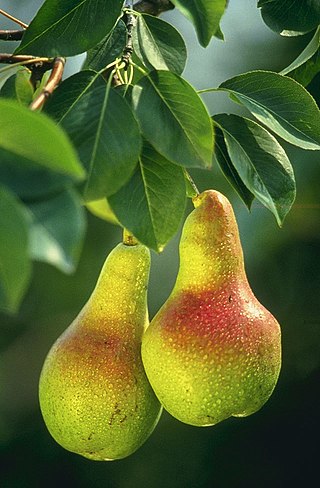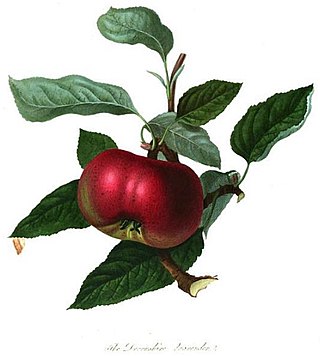
Cox's Orange Pippin, in Britain often referred to simply as Cox, is an apple cultivar first grown in 1825, at Colnbrook in Buckinghamshire, England, by the retired brewer and horticulturist Richard Cox. Though the parentage of the cultivar is unknown, Ribston Pippin seems a likely candidate. DNA analysis of major apple pedigrees has suggested Margil as the parent of Cox, with Ribston Pippin being another Margil seedling. The variety was introduced for sale by the 1850s by Charles Turner, and grown commercially from the 1860s, particularly in the Vale of Evesham in Worcestershire, and later in Kent. A paper by Howard et al seems to suggest that the Cox Orange Pippin is a hybrid between the Cultivars: Rosemary Russet and Margil based on the SNP data 7

The damson or damson plum, also archaically called the "damascene", is an edible drupaceous fruit, a subspecies of the plum tree. Varieties of insititia are found across Europe, but the name damson is derived from and most commonly applied to forms that are native to Great Britain. Damsons are relatively small ovoid plum-like fruit with a distinctive, somewhat astringent taste, and are widely used for culinary purposes, particularly in fruit preserves and jams.

Pyrus communis, the common pear, is a species of pear native to central and eastern Europe, and western Asia.

Russet apples are varieties and cultivars of apples that regularly exhibit russeting, partial or complete coverage with rough patches of greenish-brown to yellowish-brown colour. While russeting is generally an undesirable trait in modern cultivars, russet varieties are often seen as more traditional, and associated with aromatic flavours.

'Ribston Pippin' is a triploid cultivar of apples, also known by other names including 'Essex Pippin', 'Beautiful Pippin', 'Formosa', 'Glory of York', 'Ribstone', 'Rockhill's Russet', 'Travers', and 'Travers's Reinette'.

Claygate Pearmain is an apple cultivar. It was found at Claygate, Surrey in England and brought to the attention of the Royal Horticultural Society by John Braddick in 1821. The apple was a popular eating apple in Victorian times and spread through England and to America.

'Adams Pearmain', also called 'Adam's Parmane', is a cultivar of apple. It was introduced to the Horticultural Society of London in 1826 by Robert Adams, under the name 'Norfolk Pippin'. The fruit is large, varying from two and a half inches to three inches high, and about the same in breadth at the widest part. It is pearmain-shaped, very even, and regularly formed. The skin is pale yellow tinged with green, and covered with delicate russet on the shaded side; but deep yellow tinged with red, and delicately streaked with livelier red on the side facing the sun. The flesh is reddish, crisp, juicy, rich, and sugary, with an agreeable and pleasantly perfumed flavor. This Cultivar is a cross between Reinette Franche’ and ‘Reinette des Carmes. (5)
Table apples are a group of apple cultivars grown for eating raw as opposed to cooking or cidermaking. Table apples are usually sweet and the most prized exhibit particular aroma variations that differentiate them from other apples. D = Dual purpose

The Foxwhelp is a very old cider apple cultivar, originating in the west Midlands of England.

The Styre or Stire, also known as the Forest Styre, was an old English variety of cider apple which was formerly common in the Forest of Dean. It is currently thought to be extinct, but may still survive in old orchards or gardens.

The Redstreak, also spelt Redstrake, Red Streak or Red-streak, is or was a very old variety of cider apple formerly commonly planted in England.

King of the Pippins or Reine des Reinettes (French), Goldparmäne, Wintergoldparmäne german is an old cultivar of domesticated apple originating from France, and is still used in its original form as well as in many derivative cultivars that have been bred from it. It was also formerly known as Golden Winter Pearmain, because of its ripening period at late fall.

Golden Russet is an old American cultivar of domesticated apple which is excellent for fresh eating as well as for apple cider production. It is a russet apple and is therefore especially used as a cider apple. It is sometimes known as 'English Golden Russet', and has frequently been confused with 'English Russet'.

Winston is an English cultivar of domesticated apple which was first named Winter King because of its availability in the winter, but was renamed as Winston in 1944 or in 1945, after Winston Churchill.
'Clarke Pearmain', also called 'Golden Pearmain', 'Glouster Pearmain, 'Yellow Pearmain', and possibly the same as 'Columbian Russet', is a medium-sized apple cultivar. It was grown at Monticello by Thomas Jefferson.

Cornish Aromatic is an apple cultivar with a crisp, nut-like aromatic flavour that was first recorded in Cornwall in 1813.

'Nonpareil' is a class of old apple cultivars. It is a type of russet apple.
The Coccagee, also spelt 'Cackagee' or 'Cockagee' and sometimes known as the 'Irish Crab' or 'Lord Cork's Crab', is or was a variety of cider apple, known in Ireland and the West of England.

The Devonshire Quarrenden is a dessert apple cultivar historically grown and probably originating in England, although it has also been suggested as originating in France. A variety of local names and spellings, including "Red Quarrenden", "Quarrington", "Quarender", and the "Sack Apple", have been recorded in the past.
















